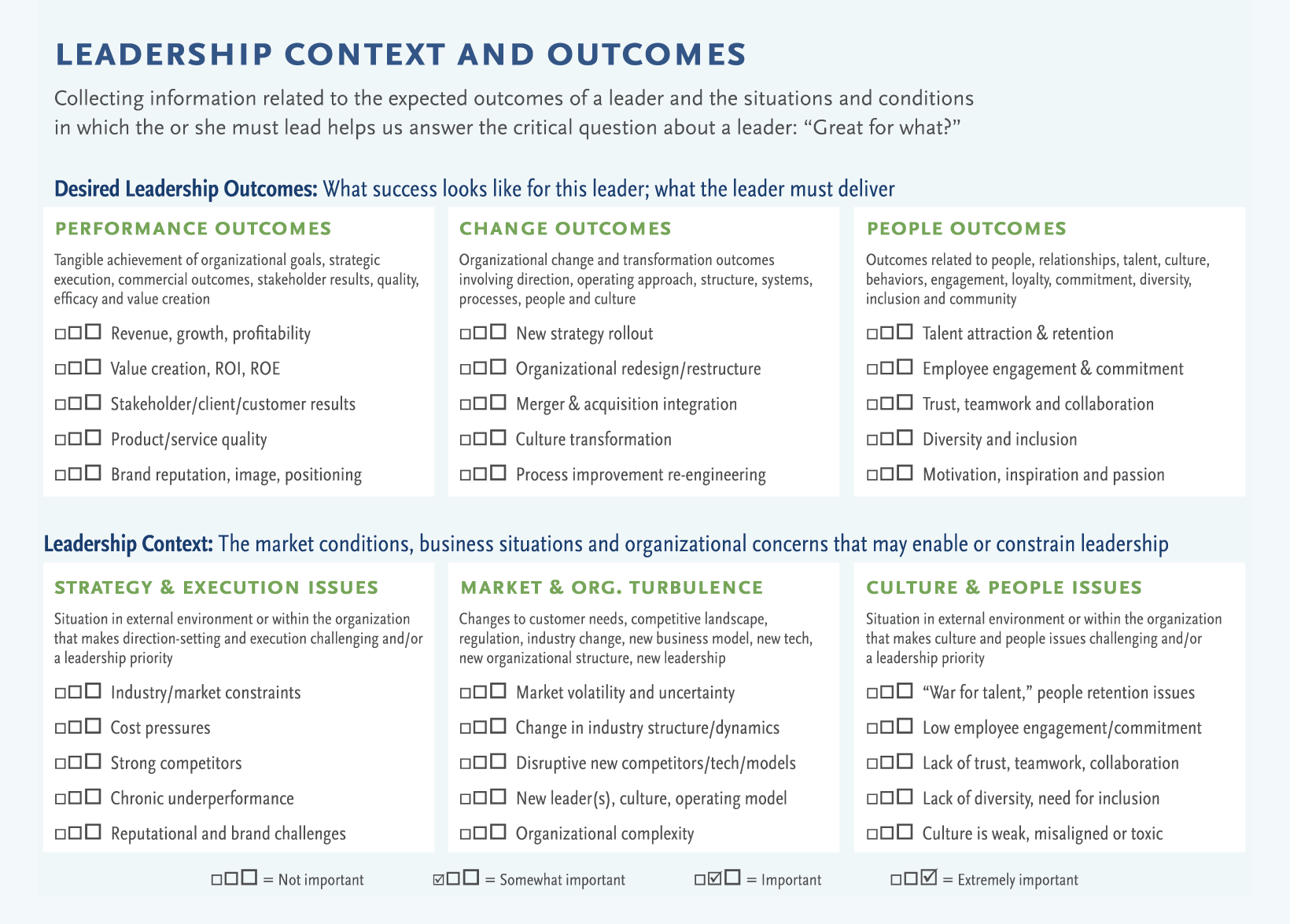No one expects a great football player also to excel at cricket, or assumes that an accomplished concert violinist could achieve the same level of virtuosity playing piano. Yet, when it comes to leadership, the idea that there are “athletes” who can excel across all situations and business challenges persists.
The persistence of the myth of the great athlete leader may be due in part to how we see ourselves: We like to believe that we are adaptable and can succeed anywhere, and tend to reject the notion that our performance may be limited by conditions outside of our control. It’s not a big stretch, then, to believe that a high-performing business leader can be successful anywhere. Our tendency to lionize leaders, especially the CEO, and the emergence of increasingly precise tools for assessing individual executives further reinforces the impression that there are leaders who can be universally successful.
A significant body of academic research, high-profile executive failures and personal experience — most of us have seen examples of the same person facing similar demands performing successfully in one situation and failing in another — demonstrate that the conditions do matter. An executive’s performance largely hinges upon how well the individual’s capabilities, leadership style and expertise align with the specific nature of the role and situation, including the demands and constraints from the team, organization and business environment. CEOs themselves recognize the risk of viewing executive performance in a vacuum. Novo Nordisk CEO Lars Rebien Sørensen had this to say to Harvard Business Review when he was named the publication’s top CEO in 20161: “My influence, through collaboration with my management team, will be assessed in 15 or 20 years, and only then will people be able to determine whether we made the right choices. Plenty of people will be willing to throw stones at us then. Again, I’m against this personal lionizing of CEOs. It’s very much a team effort.”
Horses for courses: Knowing which leadership attributes matter most depends on the context
On one level, the link between context and executive performance seems intuitive. That’s why, for example, a company undergoing a turnaround prioritizes turnaround experience when looking for a new leader. But the objectives for the role represent just part of the context that should be considered. For that reason, selecting a person with a track record of success in the same role is not a sure thing. A study of “star” stock analysts2, for example, found that few were able to recreate their success after being hired away by a new firm; the analysts’ performance fell by an average of 20 percent at their new companies and did not return to their previous levels even five years later. The success of the analysts in their old companies depended on company-specific factors — including resources and capabilities, systems and processes, leadership, internal networks, training and teams — that were different in the new jobs and difficult to recreate.
Context matters as well at the senior-most leadership levels. Even alumni of one of the most admired executive training grounds — General Electric — have produced mixed results when they moved into leadership roles at other companies, according to a study3 of 20 former GE executives who were named chairmen, CEO or CEO designate at other companies. While most of these appointments were applauded initially by the stock market and some of the leaders led their new organizations to outperform their peers — one generating nearly 70 percent annualized rate of return above similar companies — others underperformed by as much as 30 percent annualized rate of return. The study concluded, “If managerial skill is transferable … what accounts for the difference? Context.”
There is a direct link between the context of a senior leadership role and the set of capabilities, experience and style that a leader will need to be effective in that position. For a business facing a changing competitive landscape, getting the strategy right may be the main business challenge that a new leader will need to address. Culture may be the primary business challenge for an organization that faces a war for talent and needs to improve employee engagement and loyalty. Only after carefully defining the business challenge, including the underlying conditions in which executives will have to lead, is it possible to understand what kind of leader is needed.
For the senior-most leaders in an organization, especially the CEO, the context includes the external business environment, strategy, culture, organizational complexity and stakeholder expectations. Only top executives have the clear mandate and ability to set strategy for the company based on a changing business landscape, restructure the organization and reshape culture. Because the context for and demands on top leaders are so different than those faced by managers or mid-level leaders, Spencer Stuart’s approach to executive assessment includes a rigorous review of the context that takes into account these uniquely senior-leader concerns. This approach and decades of experience advising boards and CEOs across industries on senior leadership decisions enable us to provide insight on the leadership context for C-suite leaders, translate the context into the set of relevant capabilities, experience and style, and assess individuals against those requirements.
While there are many aspects of context to consider in a given situation4, in our experience these five tend to have
the most impact on a new leader’s success:

Business environment
External market conditions, including the speed of change and the degree of complexity that exists in the business environment, provide important context for leaders. This is especially true for the CEO, who is the person in the organization most responsible for scanning developments outside the company and interpreting what they might mean for the organization. The question to consider here is: What issues or situations in the external environment make direction-setting and execution challenging and/or a leadership priority? Among the conditions to take into account are the competitive landscape, changes in industry dynamics, disruptive technology or business models, and the degree of volatility or stability. A CEO can have a much greater impact on performance in a new, volatile or hyper-growth industry than in a mature, highly stable industry. Similarly, CEOs have more influence on business performance when the business has a lot of resources available and the opportunities are limited.

Strategy
An organization’s strategy is also a critical component of the overall context for a senior leader. For example, a strategy centered around differentiated products and services requires a different set of leadership capabilities and expertise from one that is focused on operational excellence and efficiency. Similarly, the capabilities of leaders of a successful domestic company may need to evolve when the company adopts a global strategy. Getting the strategic fit right was particularly important for a fast-growing consumer healthcare device company hiring a new CEO. The company was growing steadily, but the board believed that the business could grow even faster by shifting the strategy to emphasize the adoption of operational best practices globally. The new CEO had spent his career in a much larger company — with a very different organizational context — but had extremely relevant experience based on the strategic challenges, including leading highly technical manufacturing businesses in the healthcare field. His experience at larger businesses meant he knew how to scale the business and globalize. Once he became CEO, he helped the leadership team focus on the right strategic opportunities, brought in new leaders with experience operating in a larger organization, changed processes to support larger scale, and increased the speed of decision-making, spurring strong top- and bottom-line growth and doubling the share price in less than two years.

Culture
Another important context consideration is the organizational culture, and the degree to which a leader needs to align with the culture or serve as a force for change. Certain situations — such as the need to raise the bar on talent or when there are people retention issues, low employee engagement, a lack of trust or collaboration among the senior leadership team or a misaligned or toxic culture — call for a greater attention to the cultural context when making leadership decisions. For example, the ability of a succession candidate to influence the organizational culture and move it in the right direction was an important consideration for the board of a U.S.-based agribusiness. The top internal CEO succession candidate was analytical and had deep industry knowledge and a strong operational track record. But at a time of increasing volatility for the business, the board ultimately concluded that the leadership team needed to become more assertive and accountable, and the culture needed to become more results-oriented and focused on learning and innovation. The leading succession candidate strongly aligned with the current culture, which valued preserving traditional processes and collaboration over accountability for performance. The board ultimately concluded that the executive wouldn’t be able to push the culture far enough and selected another candidate.

Organizational complexity
The launch of a new business or operating model, new technology, new leadership, culture change or new organizational structure adds complexity to an organization and to individual leadership roles. Underestimating the degree of change and its impact on the organization is one reason new leaders fail, whether they were promoted from within or hired externally. In organizations undergoing transformational change, leaders need a higher quotient of interpersonal and social awareness so they are better able to bring people along with the change. Leaders who are more agile and better able to evaluate and adjust their own behavior in changing contexts are also more likely to thrive when organizational complexity is high. Consider the example of a CEO candidate for a luxury retailer who possessed all the right strategic experience — a track record of growing a specialty retail business, building a strong brand and developing a seamless multichannel business — but in a very different organizational context. The luxury retailer had a very different legacy brand and customer base, a more sophisticated supply chain with stronger negotiating power, and a capital structure that included more debt and financial pressure than the executive’s previous experience. In light of these differences in context and the fact that, when assessed, the executive scored relatively weaker in areas such as self-awareness and ability to navigate interpersonal relationships, the board was concerned that he might overlook important feedback from the organization and struggle to adapt to such different strategic and operational dynamics.

Stakeholder needs and expectations
An evaluation of the context also should consider stakeholder expectations, including those of employees, investors and customers. Failing to explicitly articulate these expectations as part of the context can lead to problems later on, even when the executive’s experience aligns with the strategic imperatives for the role. Consider the case of the highly accomplished executive who was brought in as the CEO of a private equity-backed software business. The CEO had a stellar track record and the industry, international and operational experience the board was looking for given the strategy, which involved bringing global structure to a diverse and geographically dispersed product line and applying greater operational discipline to sales, marketing and product development activities. Yet, over time, the CEO and board clashed over differing expectations about the pace of growth and the level of investment required to meet the longer term strategic objectives; the private equity firm expected the company to achieve high EBITDA targets while the CEO believed additional acquisitions were needed to build a truly global company. Ultimately, the CEO left the company and went on to be successful elsewhere.

Conclusion
Great leadership happens when an executive’s experience, capabilities and leadership style align with the specific business challenges of the role. Some business situations require transformative leaders — skilled strategic thinkers able to lead change and engage people throughout the organization. When the business is operating smoothly and predictably, by contrast, leaders have less influence. Despite the importance of context to executive success, it tends not to get the attention it deserves; we are more likely to shine the spotlight on the candidates and their respective capabilities with the goal of finding the “best” person rather than the best person given the business challenge at hand. Organizations that take a rigorous approach to defining the context and expected performance outcomes of a given leadership role, articulate the right skill set based on the business challenge and carefully assess for those requirements are most likely to place the right leaders in key roles and achieve exceptional business performance. A thorough understanding of context also enables the design of more effective transition support and integration plans for new leaders.
“The Best-Performing CEOs in the World.” Harvard Business Review. November 2016.^
Groysberg, Boris; Nanda, Ashish; Nohria, Nitin. “The Risky Business of Hiring Stars.” Harvard Business Review. May 2004.^
Groysberg, Boris; McLean, Andrew N.; Nohria, Nitin. “Are Leaders Portable?” Harvard Business Review. May 2006.^
Lorsch, Jay (201). Contingency Theory of Leadership. Handbook of Leadership Theory and Practice: A Harvard Business School Centennial Colloquium. Boston, Massachusetts: Harvard Business Press.^